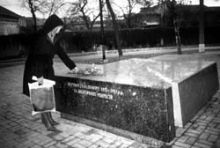Last Saturday, on the Day of Remembrance to honor the victims of the Holodomor and political repressions, a monument was unveiled in downtown Mariupol to those who died during the lawless years of the totalitarian regime. The monument was built at the initiative of the city’s historical society, Memorial.
The action group For Mariupol! was the first to propose erecting a monument to the victims of Stalinist terror in this city. The proposal was part of a resolution passed at a rally held on July 24, 1988, when the public demanded that the city, then called Zhdanov, who was one of Stalin’s ignominious lieutenants, be given back its original name. Later, on December 18, at the founding meeting of the Memorial Society the civic fathers were urged to put up a monument to the victims of political repressions. Memorial activists launched a fund-raising campaign and on November 8, 1991, a commemorative sign was installed in a theater plaza with a small plaque reading “A monument to the victims of political repressions will be erected here. Memorial Society.” An eighteen-ton granite rock symbolized inconsolable grief over the innocent victims. Numerous remembrance rallies were held at the site of this rock. The temporary commemorative sign hung there for almost thirteen years. During that time a variety of monuments cropped up in the city, but there was no money for a monument honoring the victims of the Holodomor. But the Memorial and Prosvita civic organizations constantly reminded the local authorities of the need to perpetuate the memory of the victims of the Holodomor and repressions. Addressing a remembrance rally in November 2002, Mayor Yury Khotlubei promised to hold a competition for the best design. Six artists competed in the competition, which was held in 2003. The jury selected Mykhailo Chernyshev’s sketch featuring a figurative portrayal of the Holodomor’s sorrowful “harvest.” A group sculpture depicting a famine-stricken peasant family stands against the backdrop of a granite wall with a bas-relief portraying a wheat field. A lethal scythe is suspended over the dying people. Some funds were supposed to be allotted from the budget. Yet neither the contest winner nor the residents of Mariupol ever saw this concept executed in granite. Instead, the city’s deputy chief architect Volodymyr Zemliany explained that the municipal treasury would be unable to fund such an expensive and sophisticated project. Strangely enough, when the competition was in progress, nobody noticed these “drawbacks.” It is equally odd that a huge industrial city with its half-million population could not shoulder the cost of one socially important monument. Meanwhile, the city council managed to find money to fund a “Year of Spirituality,” or rather, a Moscow Patriarchate church in Slavianohorsk. After rejecting the winner’s design, a group of architects, including V. Zemliany, the city’s former chief architect Serhiy Rudenko, and architects Yury Sahirov and Kostiantyn Okulenko, came up with a new, “more modest and less expensive,” project. Their concept specified that one composition should comprise two tragic subjects, the 1932-1933 genocidal manmade famine and the mass repressions in Ukraine. The monument consists of two granite slabs: a red one and a black one, symbolizing blood and soil, respectively. The red slab features intertwined barbed wire and the black one depicts ears of grain. A deep fault line runs between the two slabs, symbolizing the face-off between government and society.
The remembrance meeting began with a minute of silence to honor the memory of the millions of victims of the Holodomor and political reprisals. Participants unfurled Ukraine’s national flag and the banner of the UPA (Ukrainian Insurgent Army — Ed.). The unveiling ceremony was attended by local government officials. Halyna Zakharova, chairperson of Mariupol’s Memorial Society, spoke about the organization’s activities and the role it played in initiating the monument. Flowers were laid and sponsors were presented with mementos. But when survivors of repressions and relatives of those who had been rehabilitated got ready to speak, the microphone was removed on the grounds that the ceremony was over. To the astonishment and indignation of the audience, the municipal officials promptly walked off with the equipment. Valentyn Malyshev, the son of the executed sailor Yakiv Malyshev, came to see the unveiling from Italy, where he now resides, to bow down to the memory of his parents and to tell young people about those horrible times. Valentyn was eight years old in 1938, when first his father and then his mother were arrested. After his parents were executed by firing squad, the boy was taken to Germany and, after the war, to Italy. It was not until 1991 that Valentyn began visiting Ukraine every year to honor the memory of his parents at the commemorative plaque in downtown Mariupol. “I particularly revere this day. A real monument was erected in place of the stone that had stood there for 13 years,” Mr. Malyshev said. He also noted that, unfortunately, the Ukrainian government has not yet matured enough to embrace democracy; that it is standing with one foot in democracy and the other in the Stalinist regime. It was very sad, he noted, to see that people had to express their feelings without a microphone. Despite this, Mr. Malyshev expressed his gratitude to Mariupol’s mayor and the city authorities for helping to erect the monument. There are still many people at various administrative levels, especially among the communists, who are trying to prevent young people from learning the true history of their own nation. Among those who spoke without a mike was this writer, who recounted the selfless activities of the American scholar and Ukrainian patriot James Mace and his articles in The Day. The audience observed a minute of silence to honor the blessed memory of James Mace, who revealed to Ukrainians the truth behind the Holodomor.







